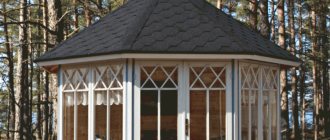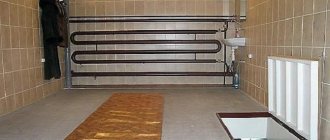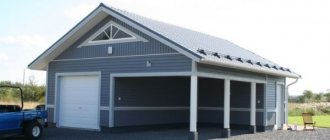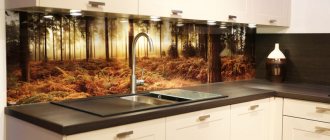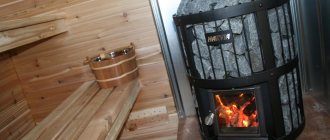Many car owners use a garage to protect their car from theft and adverse weather conditions. However, in the absence of good ventilation, extremely unfavorable conditions are created for the machine in the form of high humidity, which causes metal corrosion. We should not forget that for humans there is a danger of poisoning from gasoline vapors or other derivatives of the engine. This article will look at how to make ventilation in a garage with your own hands.
Air exchange classes in the garage
It should be noted that ventilation of a garage box with and without a basement is practically no different from each other.
Do-it-yourself ventilation in the garage can be made according to the following schemes:
- natural. Is the simplest of all. Air exchange in the room is carried out due to the difference in temperature in the room and outside;
- mechanical (forced). The system is expensive, but the most effective. Air exchange occurs due to equipment that supplies and removes air;
- combined. It works similarly to natural, differing by adding a fan to the circuit to remove air from the room.
Hood in the garage for painting cars: installation diagrams
To implement the project, a duct type fan is used, the diameter of which ranges from 150 mm to 250 mm. With the help of such a ventilation system, all gases and paint fumes are removed. In no more than 15 minutes, the air in the garage is completely replaced. The presence of an additional fan helps equalize humidity and quickly dry the car. The fan is mounted at the top under the ceiling; therefore, the air inlet is installed at a height of at least 5 cm from the floor. An additional fan is installed to create internal circulation.
Advice! To avoid the occurrence of stagnant zones, the air inlet and outlet should be placed diagonally in the room.
This installation option is used for garages with an inspection pit or basement. When implementing such a project, ventilation is removed to a separate shaft. To equip the ventilation system, pipes with a diameter of 100 mm and a length of no more than 1.5 m are used, which are insulated with 5 cm thick mineral wool. This will avoid the formation of condensation in the system and will become a reliable protector against the formation of rust.
The air duct is installed in the upper part of the inspection hole, and an inlet opening is mounted on the opposite wall. The channel is closed with a cap, which should rise no more than 50 cm above the soil. The cap can be made of sheet steel. Clean air, entering the garage through the supply opening, is distributed throughout the room and removed through the ventilation.
Important! Working in an inspection pit using chemical components is unsafe. To avoid the harmful effects of paint, it is necessary to install a reversible exhaust fan to supply fresh air. According to physical phenomena, fresh air is supplied from below, since it is colder than the air in the room. When heated, it moves, mixing with the air in the room, up to the fan and out. That is why fans are mounted under the ceiling.
For large or heavily used rooms, you will need to place two fans, which are mounted at a distance of at least 50 cm from each other.
SNiP and ventilation
For non-residential premises, ventilation standards also strictly regulate air circulation.
Building codes provide for the provision of air to a garage space in the amount of 180 liters per hour.
The circulation of air masses must be organized constantly. Let us note that in Western countries this figure is and should be twice as high.
If we talk about the materials from which the room is built, ventilation in a metal garage will be no different from ventilation in a brick or concrete garage.
Steel garage - what are the features of its ventilation?
It should be noted here that the ventilation of a metal garage is most often natural. The fact is that such structures are more mobile; they can be moved from one place to another. And the cellar in such a garage is also rarely capital. It is for this reason that it is more convenient to carry out work on the arrangement and direction of natural air flows.
As for the principle of ventilation in an iron garage, it does not differ from those described above. And if there is a need, then a forced inflow and outflow can be arranged, of course, if there is an electricity connection.
And yet, no matter how the ventilation system is built, it is impossible to do without additional equipment. After all, not only pipes and reflectors are needed, but also the hoods themselves. Let's try to look at some brands producing products in this area, and also compare their costs and some technical characteristics.
Natural air exchange installation
Due to its ease of installation and low cost, such ventilation is suitable for many. It is also commonly used for cellars.
Installing ventilation in a garage necessarily begins with calculations.
According to SNiP, for every 10 square meters of area there should be 15 centimeters of air duct diameter.
For example, the size of a garage is 5 by 4 meters. The garage area will be twenty square meters. We calculate according to the formula: 20 * 1.5 = 30 centimeters.
As a result, we obtain a channel diameter of 30 centimeters. If you plan to install two hoods and two supply channels, this value should be halved.
The figure shows the ventilation in the garage with your own hands, the diagram shows the location of the ventilation openings.
The next stage is preparing the opening for air intake. It is done using a hammer drill at a height of about ten centimeters from the floor. Proper ventilation of the garage will occur when the hood is installed in the opposite supply wall, and it is advisable that the hole be made diagonally.
Using a hammer drill we do the same thing, only under the ceiling. This is necessary because the ventilation pipe will be installed above the roof of the room to a height of approximately fifty centimeters.
Next is treating the voids between the wall and the pipe with sealant. For better bonding, you need to choose a sealant that allows you to connect different materials. At the very end of the installation, care must be taken to install protective devices. To prevent rodents and insects from entering your garage, install protective grilles. A small lid or dome will help protect against precipitation.
Thus, installation of ventilation will cost approximately 300 rubles. It is worth considering that natural air exchange is most effective when the outside temperature is less than 10-12 degrees Celsius.
Accordingly, in the summer, air exchange will be ineffective. In addition, pipes often freeze in winter, which leads to hypothermia in the room.
Material at hand
When installing an air supply system, the material that is on hand or specially purchased for this case is used. Here are the materials that can be used for installation:
- plastic pipes;
- asbestos pipes;
- sewer pipes;
- old hose from a vacuum cleaner, etc.
In addition to the above products, any item of pipe structure will do. The most important thing is to strictly follow the instructions for installing such systems.
Installation of a combined circuit
This scheme is practically no different from the previous one. In the same way, a hole will be made on one side of the garage at a height of ten centimeters from the floor. The only difference is that there is no need to make an exhaust hole in the opposite wall. Installing the fan allows you to install it anywhere.
Thus, the combined air exchange method is more suitable, as it will work effectively at any time of the year.
As for fans, many of them have minimal power consumption, so when purchasing, you should choose the one that will produce the least amount of noise.
In an underground room
Underground premises always require special attention, as they are more susceptible to moisture. High humidity not only spoils stored items, but also destroys the structure itself. Therefore, creating a ventilation system in the basement/cellar/inspection pit is a necessity. There are two types of basement ventilation: forced and natural.
Let's consider how exactly you should install ventilation in the garage with your own hands:
- Natural:
A natural system will be easiest to install. Its basis is a ventilation duct.
The width of the channel is one brick or concrete block laid on the sidewall.
As mentioned above, natural ventilation consists of a supply and exhaust pipe.
This is true for basement ventilation as well. The only difference is that the ventilation ducts of the underground room are included in the general ventilation system of the garage.
That is, the air exits through a pipe common to the entire garage.
The supply channel provides communication between the underground room, the garage and the external environment. From the basement inlet, air will flow into the entire garage. Installation of two supply channels is not required.
The pipe system creates a pressure difference, and the air begins to circulate on its own. To ensure strong air flow, pipes should be installed at opposite ends of the basement.
The supply pipe is located at a level of 30-50 centimeters from the floor (basement), the exhaust pipe is 20 centimeters from the ceiling (garage). A suitable pipe cross-section is 100-250 cm². But you should do the exact calculations yourself. The result will depend on the size of the room and climate.
Having made the calculations, you can begin installation. First of all, the exhaust duct is attached. The end of the pipe should be located 50 centimeters above the roof level. Then an inflow is installed, it goes out onto the street. It is necessary to install a mesh at the ends of the pipe, which will protect against large and small debris. A cheaper analogue to pipes is a gate valve.
Forced:
The forced system for underground premises is somewhat more complicated than the natural one, but the principle of pipe arrangement remains the same. The main difference is the use of mechanical devices. Two fans must be inserted into the cavity of two ventilation ducts. Instead of fans, you can use a vane diffuser or deflector.
REFERENCE: A diffuser-vane is installed at the top of the supply channel. The deflector creates a mass of rarefied air, thereby artificially changing the pressure.
The device is mounted at the very top of the hood. Another way is to use a light bulb. A light bulb is mounted into the cavity of the pipe. When turned on, it emits heat, thereby creating a pressure difference.
The most expensive and high-quality option for forced ventilation is modular. The air flow is controlled by a special controller. But the installation process is quite complicated and such a system is expensive. The modular option is best suited for large basements.
Read about how to make racks, shelves, a workbench and a car lift in your garage.
Mechanical air exchange
Forced ventilation in the garage is carried out by installing fans in the air supply and exhaust openings. However, there are other devices that can cope with this task.
Here are just a few of them:
- Heating lamp. Its installation is carried out in the pipe itself. Thanks to it, the air is heated, and as a result the pressure increases;
- Weather vane diffuser. It is attached to a pipe that performs the supply function. Powered by wind pressure;
- Deflector. Unlike a weather vane-diffuser, it is installed on the hood. Better exchange is ensured by air dilution;
- Monoblock. Among hood specialists, it is considered the best option for providing ventilation in the garage. Thanks to this system, the owner has the opportunity to control the entire air exchange process. Air exchange done in this way will be the most effective compared to natural and combined ones. The only negative is the cost of installation, which can reach 240 thousand rubles or more.
However, in some cases, do-it-yourself forced ventilation in a garage can be quite inexpensive. To do this, you need to do the same as for installing natural ventilation: use a hammer drill to make holes in the walls opposite each other diagonally and install pipes in them. Next, a fan is installed at the inlet openings of the air ducts.
This scheme will allow you to regulate air exchange at any time of the year. To prevent the air duct and the garage box itself from freezing in winter, you can install valves or fan speed controllers. And to protect the room from moisture in winter, experts advise covering the inspection hole or cellar.
Ventilation for spray booth
Today, many garage owners equip them with paint booths for cars. This could be a small business or a one-time use of the premises as a paint booth for personal needs. When you decide to paint your car, you need to think about a paint hood in your garage.
How to properly make a hood in a garage for painting work? It should be noted right away that there are several types of systems that are suitable for this purpose, but they all include mechanical devices. Natural ventilation for the spray booth is not effective.
Option 1. Double-motor hood. This system efficiently supplies and removes air, ensuring optimal temperature conditions in the room. This type belongs to forced ventilation systems and is installed in large workshops for painting work. The injection of air masses and the removal of contaminated air occurs using two special fans.
Option 2. Single-motor system. This type can be called combined ventilation. Air is pumped in using a fan, and air is removed naturally through ventilation vents. This system is perfect for a small room.
Installing a hood for a paint booth in a garage has certain features. The air vent in the painting room, unlike a conventional ventilation system, should be located at the bottom, or best of all, in the floor. The inlet opening should accordingly be located under the ceiling. This scheme will allow small particles of paint and dust that settle on the floor to be removed from the room along with the exhaust air.
How to make a hood in the garage with your own hands? Ventilation of the extension for painting work can be assembled from ready-made components. In this case there will be no problems. The store's consultants will make the necessary calculations and give recommendations for assembling the system.
Cars need a comfortable environment no less than humans.
This extends their service life up to two to three times. Cars, after all, spend most of their time in the garage, and the air humidity in it is of great importance.
There is only one way to regulate humidity in the garage - proper ventilation .
Ventilation also removes exhaust fumes and solvent vapors from the garage when servicing and painting the car.
And the best and most effective ventilation is forced . In this article we will talk about how to properly make a hood in a garage.
Air purification in the cellar
As a rule, a garage is used not only for parking a car, but also for storing food. Accordingly, this also provides additional moisture. But even if storage is not carried out, ventilation of the pit must be organized for comfortable work in it.
As experts note, natural ventilation is the best option in the cellar.
Provided there is good air exchange in the room, it is possible to use pipes with a diameter of 10 centimeters.
One of them is installed around ten centimeters from the floor, and the second on the opposite side, ten centimeters from the ceiling. The end of the top pipe is brought out.
It is also worth taking care of the protection of the hood.
Nuances of ventilation of the inspection pit
To ensure comfortable working conditions, the inspection pit can be equipped with high-quality lighting, various kinds of shelves designed for storing equipment, and, of course, ventilation. Let's briefly find out what this should look like.
If there is already a hood in the room, then you can simply extend the corresponding pipes into the inspection hole. As for the diameter of the air ducts, in this case it can be about 10 centimeters. The pipe supplying air should end almost at the very bottom of the pit, fix the second one on the opposite side, also moving 10 centimeters away from the top edge.
Ventilation schemes for garage
In most cases, a private garage is a small room for one car. Plus, often part of the space in it is given over to a workbench with tools and a place for storing tires, cans, etc.
Making your own ventilation in such a building is as easy as shelling pears. There is no need to make complex calculations for air exchange here. It is enough to know a couple of formulas and norms.
There are two schemes for organizing garage ventilation:
- With natural air exchange.
- With forced air circulation between the street and the room.
The implementation of both options involves the installation of two ventilation vents with pipes - one for the exhaust, the second for the supply. A forced ventilation circuit requires an electric fan. But for most garages, a conventional system with natural air draft will be more than enough. It is non-volatile, extremely easy to install and cheap.
Air circulation in a garage with a pit with natural ventilation
Flow or exhaust ventilation in a garage that requires power supply should only be done if it has heating. In this case, it is best to leave your choice on one hood. With its help, you can organize quite effective air exchange. And it will not cost as much as combined supply and exhaust ventilation. The latter consists of a considerable amount of expensive equipment, which also requires additional expenses during operation.
When choosing a garage ventilation scheme, you must also take into account the design features of the garage box. If it stands in a row of structures of the same type, then there are restrictions on making ventilation holes in some of its walls. It will not be possible to install ventilation pipes from all sides of the building. But to increase natural traction, they should be located in the garage at exactly the opposite ends.
In this case, it is recommended to opt for an exhaust, supply or combined option. These types of garage ventilation are not so dependent on the location and size of the ducts. The fan power will be more important here.
Air exchange during forced ventilation
Types of ventilation
Before making ventilation in the garage, it is worth studying its types - there are 3 in total.
Natural ventilation in the garage
Simple, cheap, but quite effective type. It uses the physical qualities of the air, so even an electric hood in the garage is not needed. Only 2 holes are needed through which air masses will circulate.
Natural ventilation is based on the balance between dirty warm air and clean cold air. Therefore, in a minimal form you will only need 2 holes. Heated air with contaminants is removed through the upper channel, and fresh cold air enters through them.
You can improve the system a little if you build it according to this scheme. Here, air will flow through the ventilation holes made on the back wall. It comes out through the pipes. By the way, in this case it is necessary to close the cellar, pit and garage basement in winter.
Advantages:
- It is cheap. You will only need large cross-section sewer pipes.
- Minimum work. You need to make holes for the pipes.
- Autonomy. The system does not depend on electricity.
Flaws:
- In the summer, when the temperature in the garage becomes equal to the outside temperature, efficiency will drop.
- The sewer pipes will not be heated and will have to be cleaned.
- Drafts cannot be avoided.
- Will have to clean frequently. In a closed or even clogged pipeline, the draft disappears.
Mechanical ventilation
Also called forced. This technology is more complicated, but it works regardless of temperature and weather. In addition to pipes, you will need:
- Air filter.
- Duct or axial fan.
- Duct heater
The system works simply:
- A fan is installed in the air duct. It will forcibly expel contaminants from the garage.
- Air from the street will first enter the filter, and then into the heater. Only then does he enter the garage.
It is convenient that the duct heater additionally heats the room. In principle, small garages with it do not need an oven or convector. In addition, you will not have to constantly open and close the basement, since the pipe can also be laid there.
This type also has disadvantages:
- Dependence on electricity. Without it, there will be no air exchange at all, so in cooperatives with unstable supply it is not very suitable.
- Electricity costs. Although not significant. Even a powerful heater with a fan will consume no more than 700 watts.
- Difficult installation.
Combined ventilation
It differs from the natural one by the fan at the outlet. It forcibly expels polluted air and increases the flow of fresh air.
The combined system is more effective than the natural one, but the tubes become dirty faster, and they need to be cleaned promptly.
Supply
The most primitive and lightweight air exchange system. It is better to do supply ventilation in a garage without a basement. However, its effectiveness is not very high.
It differs from the natural type in that only 1 channel works. It is responsible for both the inflow and outflow of air masses. Pros: maximum simplicity. You will only need 1 tube and the total costs will not exceed 500 rubles.
The downside is the system setup. Before you ventilate your garage for the winter, you will have to spend time finding a balance between the placement of the ends of the tube. The height of the draft channel directly affects the efficiency. In addition, the average precipitation should be taken into account. Snow can block the inlet and air will not flow at all.
Ventilation options in the garage
The easiest way is to install ventilation in your own garage using natural air draft with your own hands. To do this, you need to calculate the diameter of the exhaust and supply pipes, and then punch holes in the walls and/or roof and install these air ducts. The main thing then is not to forget about the need to reliably seal the gaps between the pipe and the concrete, brick or metal of the wall.
Ventilation shaft equipment options
According to the standards, the draft in the garage should be such that the entire volume of air in it is completely replaced 6-10 times in an hour. At a minimum, this is 180 cubic meters per hour per 10 square meters of garage floor. To ensure such natural air exchange, for every 10 sq.m. a pipe with a cross-section of about 15 cm is required.
The ventilation inlet should be located at a height of 15–20 cm above the ground on the wall with the door. The exhaust duct should be located opposite the first one in the roof or in the wall under the ceiling with the air duct rising above the roof about half a meter. This way the traction will be maximum. In this case, the cross-section of the supply pipe should be equal to, or preferably slightly smaller than, the diameter of the exhaust duct. If the dimensions are made the other way around, then the draft may overturn.
Layout of ventilation pipes in a garage with a pit
The effectiveness of natural ventilation in a garage depends on:
- differences in air temperatures inside and outside;
- the presence of wind outside and its strength;
- pressure difference between the upper exhaust point and the lower inflow point;
- location of ventilation pipes on the facade and the degree of their insulation.
How to position a ventilation shaft for better draft
There are many influencing factors. Therefore, it is often necessary to create a ventilation system that operates thanks to the forced draft of air masses. Here the calculation of parameters is even simpler.
Pipes can be taken in half the size as in the option discussed above. All the same, air exchange will be carried out due to the operation of the fan. Its power is selected based on the cubic capacity of the garage and the required air exchange rate. In the vast majority of cases, a 100 W axial channel model is sufficient.
Pipes and holes are located in the same way as in the version with natural draft. At the same time, it is often easier to do ventilation with forced exchange yourself. Air ducts are required to be smaller in diameter. This means that smaller holes will have to be punched in the walls. However, due to the presence of electrical equipment, such ventilation will be more expensive than its conventional counterpart.
Diagram of air flows for different types of ventilation
If you are installing a fan, you should take a model with a timer. Leaving it on all the time is not profitable for money (light bills will be considerable) and dangerous due to the risk of fire. Working electrical equipment should not be left unattended for a long time.
Scheme of natural ventilation in the garage
And so you can set the desired mode so that the fan turns on for a while to completely replace the air in the room, and then immediately turns off. After all, a garage ventilation system is being built, and not ventilation in the bathroom and toilet, where air circulation must be continuous.
Types of ventilation
No matter what kind of garage you have, whether it has a basement or an inspection hole, ventilation is a must.
There are several types of ventilation for such a room.
Natural
Natural ventilation is the most budget option.
Fresh air enters the garage due to the difference in temperatures outside and inside the room. For natural air circulation, it is necessary to provide 2 ventilation holes - supply and exhaust. Air renewal will be helped by a deflector placed in the exhaust vent. A low-pressure area is created near this device, which allows air to be quickly removed.
Air currents move thanks to ordinary physical laws:
- The difference in the density of cold and heated air.
- Impact of wind currents.
- Movement of air masses as a result of the interaction of high and low pressure.
When using natural ventilation, do not forget:
- In summer, air circulation decreases noticeably.
- Due to a sudden change in pressure, drafts may appear.
- It is necessary to constantly monitor the condition of the ventilation openings and clean them if necessary.
This type of ventilation is mainly suitable for those who do not want to spend a lot of money.
Forced
Forced ventilation requires careful design.
It makes it possible to partially or completely eliminate additional heating of the garage, bringing the air temperature to 5 degrees Celsius. The supply part contains a filter, a fan and an electric heater. Air is removed from the room using an axial or duct fan, which is installed in the air duct. Before air enters the room, it passes through a filter and is heated by a heater. Exhaust air is removed when duct fans operate.
Forced air exchange during design requires correct calculations to accurately determine the required cross-section of the air duct, fan power and other operating parameters . Most often, ventilation ducts with a cross section of 160-180 mm are created. For such a design, it is important to correctly place the holes at different ends of the room diagonally.
Combined
Combined ventilation differs from natural ventilation in the presence of additional equipment
. A type of natural ventilation, it differs only in the removal of exhaust air - the process occurs with the help of additional equipment . With this method, an electric fan is placed at the exhaust vent. The ventilation method is independent of changes in nature and requires less cost than forced ventilation. The disadvantage of this method is that the air flow is not cleaned or heated, and the ventilation ducts must be constantly monitored and cleaned of dirt and ice.
Supply
Supply ventilation does not remove exhaust air, but renews it.
In this name, the word “supply” indicates that the main function of ventilation is not to remove exhaust air, but only to update its volume by pumping in fresh air .
The design of such ventilation sets its own requirements:
- Ventilation outlets, unlike the exhaust system, should be low, ideally at a maximum height of 30-50 cm from the floor.
- The exits in this system must be made 2 times wider than with exhaust ventilation.
- Channels must be placed so that wind flows blow into them more often. It is most convenient to organize the flow of fresh air into the room by installing a grille at the bottom of the gate. If you have a long garage, it is best to place the ventilation ducts in a long wall in the center of the garage.
Holes are made in the wall in a suitable place, and corrugated pipes are installed in them. Please note that for good performance of such a system it is necessary to create a maximum difference in height between the channels, for this you will have to find a long pipe. But with a low garage roof, you can make the corrugated pipe higher by extending it with a plastic pipe. As a result, we will be able to obtain the required height difference.
Installation nuances and calculation tips
Garage ventilation with natural air exchange should be designed so that there is a distance of about 3 meters between its lower and upper points. If it is less, then the thrust will be reduced.
Ventilation design elements
To prevent the garage from freezing in winter, it is necessary to be able to adjust the volume of air passing through the hood. To do this, it is recommended to choose ventilation grilles with adjustable blinds for installation. If necessary, they can be closed and then opened fully.
Air exchange during forced ventilation with heating
If there is no heating in the garage box, and sometimes heating is required, then it is worth installing a supply ventilation system with a heating element. Such ventilation in the garage will allow you to quickly heat it up when necessary. An electric air heater consumes a lot of electricity. But for short periods of turning it on for heating, if necessary, to repair the car in winter, this is just the thing.
Ventilation diagram for a heated garage
Each of the pipes (exhaust and inflow) must have the same diameter throughout its entire length. Narrowing is unacceptable here, and there should be a minimum of turns. Fortunately, in most garage spaces they can be made vertical without horizontal outlets.
Materials for the device
These include:
- axial (duct) fans;
- air ducts;
- clamps and fasteners;
- sealant, sealing tapes and sheets for gaskets;
- cements, putties, polyurethane foam.
Main characteristics of fans suitable for garages:
- supply voltage: 220 (230) V, 50 Hz;
- power consumption: 20 – 50 W;
- air flow: 150 – 300 m3/h;
- pressure: 50 – 100 Pa;
- channel diameter: 120 – 150 mm.
Air ducts currently sold are metal and plastic . Metal ones are divided into galvanized steel and stainless steel with wrapping. Plastic ones are smooth and corrugated. According to their shape, air ducts are divided into round and rectangular. To connect different shapes together, there are adapter connectors.
The choice is quite large. When using corrugated air ducts, you should remember that they swirl the air very strongly and slow down the flow. They can be used for short runs and for joints. You should prefer ducts that are as smooth inside as possible. Related to this is the following
The use of other materials is obvious. All clamps, fastenings and transitions can be purchased along with standard air ducts Cement may be required to embed fan mounts and transitions into walls, and sealant and foam to seal joints in certain places.
Organizing forced exhaust ventilation in a garage has such obvious benefits that it should not be missed. It works in any weather, including in the heat, in which no other ventilation will work. In addition to preserving the car and other equipment, the owners of such garages will save an even more valuable thing - health.
Well, and besides, a home-made garage hood is quite affordable for anyone, even the most modest budget .
What is it for, requirements
Due to the periodic use of this building, energy-independent natural ventilation through vents or ducts is preferable. When designing ventilation in a garage with your own hands, the diagram and photo may differ slightly depending on the presence of an underground vegetable storage cellar.
Scheme of natural air exchange of a garage without an inspection hole or cellar
The basic requirements are specified in SP 7.13130; when storing vehicles, the air must be renewed hourly; when the engine is running, the air exchange rate must increase to 4. Therefore, axial and radial fans are often installed in the exhaust and supply ducts, turned on as needed by the owner.
Forced mechanical ventilation diagram
Lack of air flow leads to the following consequences:
- reduction of vehicle life due to body corrosion;
- destruction of garage load-bearing structures from excessively humid air;
- danger of poisoning from car exhaust.
Exhaust gases will accumulate in the room without an exhaust hood
Tools and materials
To get the job done quickly, prepare the necessary materials and tools in advance:
- Powerful hammer drill;
- Angle grinder;
- Thermal insulating material and sealant;
- Grilles to protect channel outlets from dirt;
- Pipes made of plastic or metal of the required diameter.
In addition, depending on the design, fans may be required:
- Exhaust duct devices are easy to use and accessible. Built-in regulators allow you to change the intensity of air replacement. The optimal diameter is about 160 mm. But it is cheaper and easier to use products with a diameter of 120 mm.
- Centrifugal - they work best for exhaust, but they are more difficult to install. They are mainly used in garages where cars are painted.
- Vortex units are the most suitable units for removing welding smoke.
For an ordinary garage, the most practical option is a ducted exhaust fan. This device is inexpensive and serves its purpose well.
Various ventilation schemes, how to do it yourself
Depending on the budget of the car owner, for ventilation in the garage with your own hands, the scheme may have several options:
- natural - an inlet opening at a level of 15 cm from the floor, an exhaust hood at a similar distance from the ceiling, a pipe connected to a pipe rising 50 cm above a flat roof or the ridge of a pitched roof is inserted into it;
Natural ventilation scheme
- forced - both air ducts are equipped with fans of the same power;
Axial fan built into the duct
- exhaust - the fan is mounted only inside the hood.
Exhaust fan
Supply ventilation vents are located near the ground, so they are equipped with screens to protect against animals and rodents or are decorated with gratings. Canopies or weather vanes are mounted on the vertical exhaust pipe to protect against the penetration of precipitation.
Ventilation protected by metal mesh
Air exchange inside the cellar
If there is a cellar, the ventilation scheme in a metal garage with your own hands becomes more complicated:
- an independent ventilation system can be installed in the underground room;
- the supply opening can be located in the ceiling of the cellar, the hood can exit through the roof or outside along the wall of the garage.
Related article:
Organization of air exchange in a garage cellar
Supply pipes inside garage walls are relevant for significant masonry thicknesses. If the wall is made of brick, leave square windows decorated on the outside with bars.
Ventilation duct in the garage wall
The main difficulty in organizing natural air exchange is due to the lack of heating in the garage and the location of the supply ventilation ducts almost near the ground. Most often, the ventilation ducts of the cellar become clogged with frost, since the humidity inside it is high from stored vegetables. Therefore, regular cleaning or installation of valves is required.
Organization of natural ventilation in a garage with a basement and inspection pit
A normal pressure difference is considered to be a level of 3 m vertically between the inlet and outlet. In a standard garage this is not achievable by default, so combined, mechanical air exchange systems are used.
Inspection pit
The inspection hole also becomes the weak link of the ventilation systems. Despite the fact that it is located indoors, natural ventilation cannot ensure the exchange of air masses inside it.
Ventilation of inspection pit
The only option in this case is to install air ducts near the floor of the pit, in its upper part. When using fans inside ducts, this problem is completely eliminated.
Nuances of ventilation of the inspection pit
The inspection hole, like the basement, is also a source of condensation, which, as mentioned earlier, can lead to a number of problems that negatively affect the safety of the car. Despite the fact that it is located indoors, it is impossible to organize high-quality ventilation in it through natural ventilation.
It would seem advisable to install ventilation in the garage itself, since the car is parked there, and not in the inspection hole. But in fact, the pit is a source of moisture, because it is located below the level of the room and, as a result, condensation can accumulate in it, which will subsequently spread throughout the garage.
The pit itself must be kept in proper condition. It is necessary to remove fumes from chemical compounds and odors from synthetic products used to service the vehicle. The air there should be fresh, since many motorists can stay in the inspection hole for a long time.
In the case of an inspection pit, the hood can only be installed near the floor of this section of the garage building. If you use a fan, you can get rid of the problem of moisture accumulation in the pit and, as a result, on the lower part of the machine.
By equipping the floor surface with a “warm floor” heating system, you will not only prevent the formation of condensation, but also help create a suitable microclimate in the garage that ensures all the rules for storing a vehicle.
Installation of forced ventilation
In most cases, installing a fan in the gap in the exhaust duct is sufficient for a garage. In this case, do-it-yourself ventilation of an iron garage, the diagram of which is given below, is installed in stages:
- supply channels are cut in one wall;
- Pipes are installed in them, the joints are sealed with sealant;
- an axial fan is mounted on the inside of the exhaust pipe;
- a similar scheme is used in the basement.
Installation of forced ventilation in the garage
When calculating the cross-section of the air duct, standard solutions can be used, since the size of garages is usually standardized to 6 x 4 m. The standards indicate that for every 10 m2 a pipe with a cross-section of 15 cm should be selected. If you cut two holes and install standard 11 cm pipes in them, you will get a significant supply.
When choosing mechanical ventilation, the hood can be mounted on any walls. The diameter of the channel completely coincides with the supply pipe. There are several types of supply and exhaust ventilation:
- modular is mounted from separate blocks, the operation of which is coordinated by sensors;
- monoblock has a recuperator design (pipe in a pipe), the inner pipe is used for exhaust, the supply channel is located between the walls of the pipes.
The latter option allows you to reduce the number of nodes for entering engineering systems through walls; it can be used in a surface garage and underground vegetable storage. For a cellar, a recuperator is especially relevant, since it allows the vents not to be closed during the winter, the cold air is partially heated by the warm air escaping, and the vegetables do not freeze.
Recuperator for cellar
The VSN 01-89 standards recommend two-level ventilation for industrial garages. Car exhaust is heavier than air, so it accumulates in the lower level. Therefore, when the engine is regularly turned on for a long time indoors, it is recommended to install supply ducts and hoods at different heights. In this version, the inspection hole and the hatch of a leaking cellar become areas of increased danger.
Scheme of two-level garage ventilation
Therefore, SK-125S fans (or a similar analogue) are usually chosen for mechanical air exchange systems. For the latest operating conditions, you should select the power of the electrical appliance according to a similar characteristic of the vehicle:
- 800 cubic meters per hour for a 240 liter car. With. (175 kW)
- 650 m 3 /h for machines 180 – 240 l. With. (130 – 175 kW)
- 500 cubic meters for equipment 120 – 180 l. With. (90 – 130 kW)
- 350 m 3 /h for cars up to 120 l. With. (within 90 kW)
Fan installation
The fan is installed on the ventilation duct. It is necessary to arrange two channels:
- for the flow of fresh air from the street, which is mounted below;
- to eliminate the dirty that is created near the ceiling.
Advice! It is better to design the holes when building the garage. If a finished room is used, holes are made using a hammer drill at a height of more than 5 cm from the zero point of the floor.
The hood is mounted on the wall opposite the air supply as high as possible. The fan must provide an air flow speed of 25 cm/s. So, for example, a painting booth with an area of 28 m2 requires equipment of 2500 m3/hour.
Combined ventilation
Such a system has good efficiency, while making it possible to save on equipment and electricity.
Separately, you can create a ventilation system for the inspection pit
The principle is the distribution of air flows: one of them is natural, and for the other an automatic mechanism is used.
You need to install an exhaust fan in the outlet hole - it will free up space by sucking waste material out. Fresh ones will fill the free volume that appears naturally. In this design, the location of the inlet and outlet passages does not matter: they can be mounted where it is convenient.
The disadvantage of a combined ventilation device is the need to constantly turn the equipment on and off. It is easy to solve the problem using programmable equipment with a timer, but you will have to spend money on such equipment. Another disadvantage: the wind flows inside naturally, which means it is not heated or purified. Because of this, the exhaust device will periodically become clogged, which requires regular cleaning and preventive measures.
Great article 13
- Even more interesting:
Calculation
Garage ventilation diagram
Before starting ventilation installation work, you need to calculate the required diameter of the ventilation ducts. This is done in two ways:
- According to the formula, for 1 m2 of the area of the entire garage it is necessary to take 15 mm of pipe diameter. For example, for an area of 10 m2 it is necessary to use a pipe with a cross-section of 150 mm.
- The sum of the cross-section of all holes = 0.3% of the garage area. This formula is mainly used when creating a single-channel mechanical ventilation system.
According to SNiP requirements, 180 m3 of air per hour must be supplied to a building where there is room for one passenger car; abroad this figure is twice as high.
Now a few words about the features of calculating natural ventilation. A sufficient natural flow of fresh air into the garage is possible only if you install 2 ventilation pipes - supply and exhaust. There is no need for special knowledge for calculations, the main thing is to follow the basic rules:
- The supply opening is placed on the windward side of the garage, approximately 10 cm from the floor surface, the exhaust opening is 10 cm below the ceiling. They should be in opposite corners of the room.
- The air duct is installed 30-50 cm above the roof. It is protected with insect mesh and fungus from rain and snow.
If, according to calculations, you require a ventilation duct with a diameter that is too large, then it is much wiser to use smaller pipes, but install 2-3 pieces.
What you need to prepare to get started
Tools you need to have to install the hood:
- Bulgarian;
- perforator;
- sealant;
- plaster.
To assemble the structure itself you need the following materials:
- pipes made of metal, plastic or asbestos of suitable diameter;
- protective grilles;
- fans - if a mechanical type system will be installed.
Sometimes the device is made from sewer pipes. But it is better not to use this material for the supply hole to avoid the toxins released by the plastic from getting inside.
Having chosen the appropriate option and prepared everything you need, you can begin installation.
Step-by-step instructions for installing ventilation
Let's look at the process using natural ventilation as an example.
The most difficult thing to do in a garage is to create natural ventilation for the cellar, so it is better to consider creating such a system as an example. It is based on the correct installation of the exhaust and supply pipes at the required height. The supply pipe brings fresh air into the room from the street, and the exhaust pipe serves to remove the exhaust pipe.
It is not advisable to deviate from the calculations - this way you can ensure maximum system performance.
For the manufacture of air ducts, it is best to use galvanized or asbestos pipes of suitable size.
A through pipe can be installed in two ways:
- Through - a ventilation pipe is passed through the floor of the garage and then brought out through the roof.
- Wall-mounted - the exhaust pipe is embedded in the cellar wall and taken out beyond the boundaries of the building.
Thanks to this, a difference in temperature is achieved inside the garage and outside, which allows the air to be renewed naturally. To enhance traction, a deflector is attached to the pipe; in addition, it protects the pipe from the penetration of dust and debris.
For ventilation, you can use asbestos pipes; tin and plastic products are often used. The most durable and practical are plastic pipes. They are good because:
- They last a very long time;
- They withstand mechanical stress well;
- Good resistance to aggressive environments;
- They are easy to process, such products weigh very little;
- The surface of the pipes is slippery and almost no contaminants remain on it.
For this reason, making ventilation ducts from inexpensive and practical plastic pipes is most convenient and accessible.
When manufacturing a ventilation system, the garage owner does not need to overhaul the entire structure. All the work consists of buying a set of pipes of suitable diameter and installing them in the right places in the building. Holes in the walls are made using a hammer drill. After the pipes are secured, the holes must be sealed well.
In order for you to have a fully functional ventilation system, the height difference between the supply and exhaust pipes must be at least 3 meters. Only in this case is high-quality air exchange possible. The part of the pipe facing the street must be insulated. It is advisable to install shutters on the supply and exhaust openings, which will allow you to easily regulate the strength of the air flow in winter.
It is advisable to make forced ventilation in the inspection hole or in the basement. To make it you will have to buy suitable fans. Without them, during the warm period it is very difficult to create reliable air exchange, because with natural ventilation it is 100% dependent on temperature changes.


